#ancient greek cult
Explore tagged Tumblr posts
Note
Hi dear. I've been following your comics for a while now. I also absolutely adore your Dionysus and it seems like you do as well! Do you have any book recommendations for someone who wants to learn more about Dionysus as a god associated with sex and subversion of sexual roles? I can't seem to find satisfying answers from just theoi.com alone.
Hi! Dionysos certainly is a fascinating character. I'm glad you like my version of the god. ^^
Unfortunately I haven't read any book that focuses entirely on this aspect of Dionysos. It is mentioned briefly in the chapter "Sexuality and the Gods" in Greek and Roman Sexualities: A Sourcebook by Jennifer Larson.
One article that Larson recommends for further reading is "Riding the Phallus for Dionysus: Iconology, Ritual, and Gender-Role De/Construction" by Eric Csapo.
It is also discussed a bit in the chapter "The Anthesteria and other Dionysiac Rites" in Polytheism and Society at Athens by Robert Parker.
In Ancient Greek Cults: A Guide, Jennifer Larson means that the analyses of how Dionysos subverted gender roles and other societal norms are largely based on the portraits of Dionysiac worship in Greek poetry and myth, above all the Bacchae of Euripides, but that a study of Dionysos' cults and the historically attested behaviors associated with them yields a different picture:
"In practice, the worship of Dionysos was not truly subversive; instead, it offered outlets for physical and emotional self-expression within socially acceptable contexts. Furthermore, Dionysiac cult was smoothly integrated into Greek civic systems of worship, with ecstatic and private components balanced by state-sponsored festivals and conventional sacrifices."
If anyone knows any good books or articles on this subject, feel free to add.
24 notes
·
View notes
Text
Hear me out, here me out…
“And that it was from Chaos that the first three primordial gods sprang forth: Gaea (Earth), Tartarus (the Underworld), and Eros (Love) - Hesiod's Theogony
Gaea/Earth: Ariadne
Tartarus/The Underworld: Eurydice
Eros/Love: Caeneus
Purely me headcanoning my heart little away. But I love how in a sense they all represent the three eternal beings ‘of chaos’ that make up creation incarnate.
Ariadne: Who is now the ‘Mother of her people and her land’ as president. A representation of feminine power. Life
Eurydice: The first person to return from the Underworld and essentially, conquer/master death. Death
Caeneus: Sweet, sweet Caeneus who embodies love, the driving force of creation. Love
They don't embody the return to Chaos per say, rather the power that sprang from it. The necessary cycle of death and rebirth, destruction and creation that Zeus has selfishly stalled. That they, as a trio will restart.
#And then you have Orpheus and Dionysus#A strange duo until you consider both the Orphic and Dionysian Mysteries both revolved around that same principle of Death and Rebirth.#Orpheus is said to have been a prophet of Dionysos who established the Dionysian mysteries#And#Spoilers for an ancient Greek mystery cult prophesy here#Prophisied Dionysus the twice born taking Zeus's place as king of the gods#It's all about death and rebirth and love#It's all about that ever turning cylce#Anywho#Thank you for listening to my Ted talk#😅#kaos netflix#kaos#caeneus#ariadne#eurydice
179 notes
·
View notes
Text
Dionysus ✦
God of wine, fruit, pleasure, ritual madness, lgbtq+ community, fertility, theatre, festivity, insanity and intoxication

Offerings :
Wine
Honey
Olive oil
Apple seeds or apples in general
Grapes
Ivy
Frankincense
Roses
Cinnamon
Pinecone
Fig
Silver fir
Theatre masks
Snake imagery
Bull imagery
Leopard imagery
Pride flags
Cups
Sex toys
Purple candles
White candles
Curved knives or daggers
Devotional acts :
See a theatre show
Go to a party
Wear purple, red or white clothes
Go to a pride event or support lgbtq+
Tell someone you love them
Love yourself.
Write poetry or music
Read poetry
Listen to music that reminds you of him
Drink wine (grape juice if you're underage)
Go dancing or dance at home
Masturbate
Go to festivals
Take care of your mental and physical health
Draw pictures of things associated with him
REMINDER you don't need to do any of these things to worship a deity, these are just suggestions, remember that if you don't want to or can't do any of this that it's totally ok !!
#greek mythology#greek gods#myth#dionysus#dionysos#dionysian#cult of dionysus#offerings#hellenic devotion#devotional acts#praise dionysus#dionysus devotee#ancient greek mythology#ancient greece
96 notes
·
View notes
Text

The Temple of Artemis at Brauron (now Attica)
#artemis#greek mythology#cult#greek gods#greek goddess#artemisia#ancient greece#ruins#greece#abandoned#brauron#cult of artemis#witchcore#witchblr#attica
149 notes
·
View notes
Text

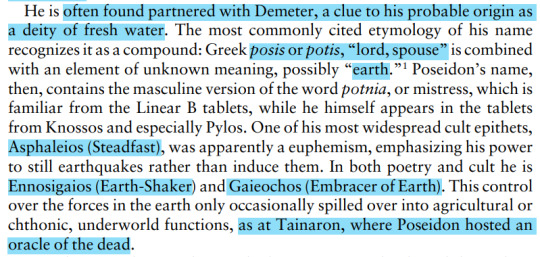
I'm two paragraphs into Poseidon's chapter in Ancient Greek Cults by Jennifer Larson and I'm already wanting to bite something
#i LOVE poseidon. thank you.#poseidon#poseidon deity#poseidon worship#hellenic polytheism#ancient greek cults#jennifer larson#hellenic reconstructionism
353 notes
·
View notes
Text



Dionysus. Did I mention I love Dionysus?
#he is fr so cool#my man literally had mystery cults he was so cool#greek mythology#greek myth art#dionysus#homeric epics#Ancient Greece#my art#my doodles#dionysus greek mythology
41 notes
·
View notes
Text
Been awhile since I’ve hopped on here, but just wanted to let folks know that you can read an essay of mine called “Entering the Temple of Medea” in the new volume The Many Gods Anthologies: Hekate. It interrogates the function of hero cults in Ancient Greek religion, and how we might apply that lens to Medea in relation to Hekatean devotion. Very proud of this piece and would love to hear people’s thoughts about it. Hope you enjoy!

47 notes
·
View notes
Text
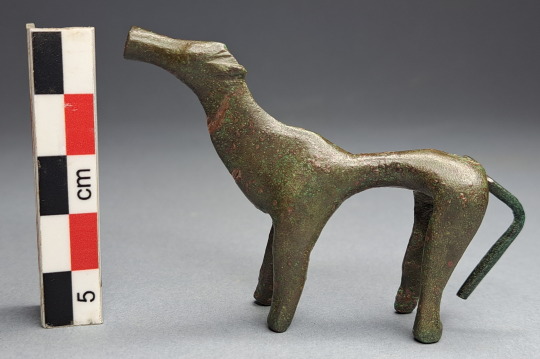
2,600-Year-Old Artifacts Found at Ancient Greek Cult Center
Around 2,600 years ago, the Greek city of Helike was destroyed when a violent earthquake and tsunami struck the region, leaving the city buried.
Archaeologists and researchers have pursued explorations of the city’s remains for decades, and recent excavations have begun uncovering more about Helike’s cult center, according to a news release from Greece’s Ministry of Culture.
Previous excavations of the site revealed an arched temple dating between 710 and 700 B.C., with a brick altar dating to 760 to 750 B.C., officials said. The latest round of excavations, from May 2 until June 23, focused on the remains of two more buildings and more religious remains.
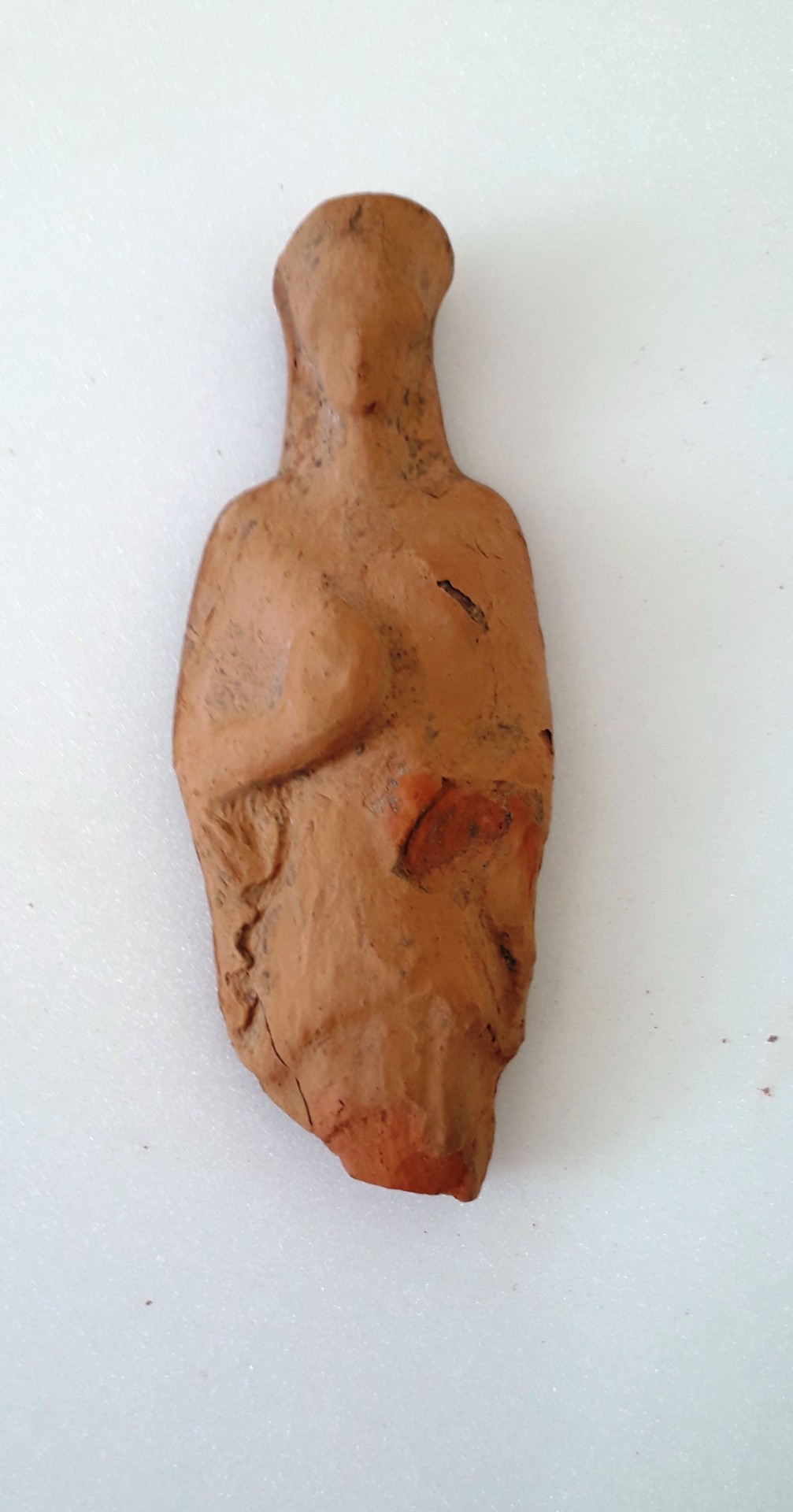
Experts said the first building they explored dates to the eighth century B.C. It had pressed soil floors and an approximately 60- to 65-foot-long wall, and it appears to have been used in three different phases.
The remains of the second building included a temple-shaped stone foundation dating to the seventh7 or sixth century B.C., officials said.
It was filled with light pottery dating to the Archaic era — which lasted from around 800 B.C. until 479 B.C., according to the World History Encyclopedia — as well as clay figurines and a bronze snake head, archaeologists said. A clay wing that belonged to a depiction of a mythological figure was also found during the excavations.
East of the two buildings, researchers unearthed a number of artifacts dating to the eighth and ninth centuries B.C. Experts said these discoveries confirm the use of the space for religious purposes as early as 850 B.C.
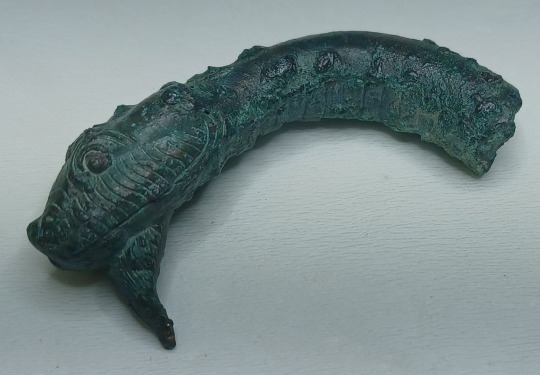
Among their finds, archaeologists identified offerings to the sanctuary’s deity — Poseidon— including clay and bronze figurines, clay chariot wheels, bronze buckles and pins, iron weapons and a rare piece of a golden necklace, according to officials. Evidence of a second deity was also found at the site.
The building remains also revealed that the area was subjected to frequent floods, experts said. This finding indicates that its residents felt a connection to the area because rather than relocating, they continued to build and rebuild the site.
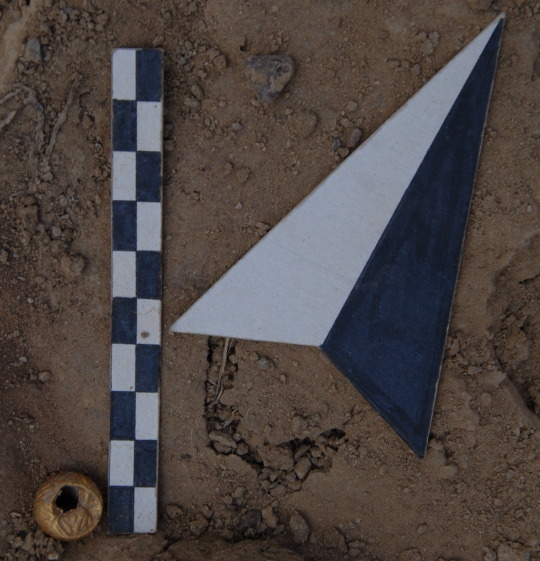
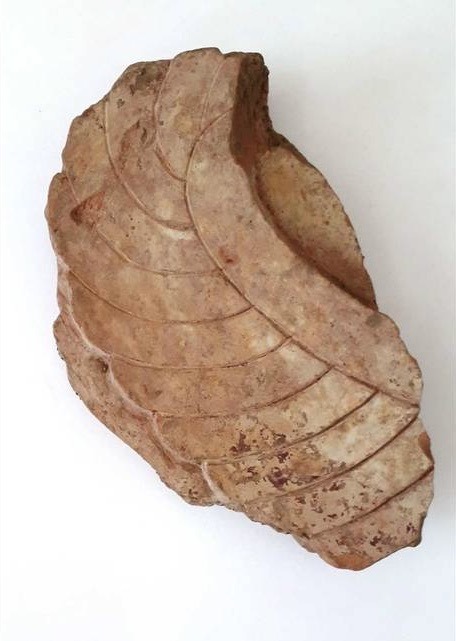
Archaeologists said they also found evidence of animal sacrifices, including goats, sheep and pigs, at the site. There was also indications of grape plant remains, pointing to the importance of wine for rituals at the sanctuary.
Helike was on the southwest shore of the Gulf of Corinth, according to the Helike Project. The Gulf of Corinth is about 66 miles northwest of Athens.
By Moira Ritter.
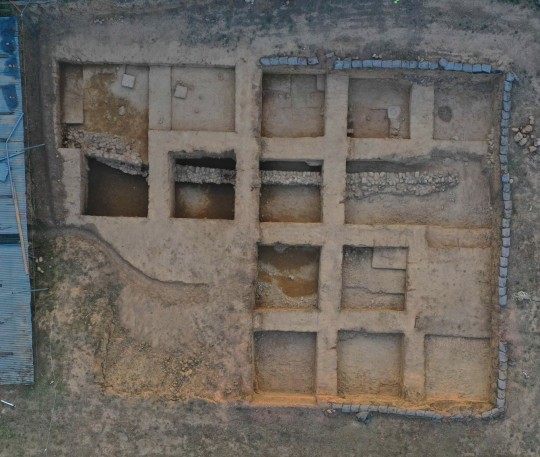
#2600-Year-Old Artifacts Found at Ancient Greek Cult Center#Helike’s cult center#ancient artifacts#archeology#archeolgst#history#history news#ancient history#ancient culture#ancient civilizations#ancient greece#greek history#greek art
172 notes
·
View notes
Text
It’s just a fraction of a second at the end of this 15-second scene, but the look on Roger Allam’s face is so droll I had to share it for what I’m calling…
“Deadpan Dad”
#my smart boy#Dad’s proud#even if he has no idea wtf you’re talking about#Oxford’s loss is Cowley’s gain#itv endeavour#endeavour itv#endeavour: home#love this show#shaun evans daily#shaun evans#endeavour morse#roger allam#fred thursday#father figure#deadpan dad#cuppa#The Trachinae#(It’s a tragedy. By Sophocles.)#epic acting#endeavouredit#hot damn evans#not a cult#just a like minded group making merry and enjoying all the references to Ancient Greek tragedy
22 notes
·
View notes
Text
The myth of Dionysos (3)
For the previous posts, see here and here.

V) The cult of Dionysos : Outside the city, inside the city
Such a god apparently does not have his place in the Ancient Greek city. Séchan-Lévêque reminds us that his religion, at the same time joyful and wild, is centered around the “thiasus”, that is to say a gathering of male and female beings joining outside of any civic or familial setting. According to Euripides’ description and to the various visual depictions of Ancient Greece, all the cultural elements surrounding Dionysos are the very opposite of the rational organization of a State. His cult takes place on the countryside, in woods and mountains. It takes place at night. The participants wear an animal skins over their clothes (or replacing their chiton), their hair is wild or crowned by ivy or laurel, their belt is made of a snake or a baby leopard hangs from it ; in one hand they hold the thyrsus and in the other a small animal (hare or young fawn). The music played for Dionysos is strange: flutes, tympanum and castanets. His ceremonies are chaotic: wild dances, convulsions, exhausting races. His sacrifice is performed by ripping apart animals before eating their raw flesh. The thiasus could be made of men, but the most famous of all the thiasus is the female one, and its members are called the Menads, the Bacchants, the Thyads, the Bassarides… Ordinarily, women of Ancient Greece were locked up inside the gynaeceum, so to have them becoming wild and savage makes the cult of Dionysos a unique one, set apart by the official religious events of the city, since he breaks all urban religious rules. Similarly, the mysteries of Dionysos unite together men and women, citizens and slaves, which meant breaking apart the Ancient Greek social hierarchy.
And yet, this Dionysos that destroys the order of the city is greatly honored at Delphi, the domain of the Greekest of all gods, Apollo. The Pythia reminds the audience, in Aeschylus’ Eumenids, that she honors the nymphs over which rules Bromios and his Bacchants, with explicit references to the story of Pentheus. Every year, during the three months of winter, while Apollo leaves for Hyperborea, Dionysos replaces him. And every two years, the Thyads of Delphi and the Bacchants of Athens, holding torches, celebrate on mount Parnassus the son of Semele. In the adyton of Apollo’s temple, legends claimed Dionysos’ tomb could be found. The poets frequently exchanged the names and nicknames of the two deities: Aeschylus wrote in Bassarids of “Apollo with ivy, a bacchant and a seer”, while Euripides in Likymnion wrote of “Lord Bakchos, friend of the laurel, Pean-Apollon with the beautiful lyre”. As such, despite Nietzsche’s strict opposition between the god of harmonious restraint and the deity of savage drunkenness, the two gods are actually far from being polar opposites.
Dionysos also finds a home at Athens. We already saw several of the festivals in his honor there: Apaturia, Anthesteria, Oschophoria… But to those can be added the agrarian Dionysia, the the Lenaia, and especially the great Dionysia: during those, contests of dithyrambic, of tragedies and of comedies were held, gathering an audience coming from all four corners of Greece. Traditionally, the tragedy, the “tragodia”, is read as meaning “the song of the goat”, tragou-ôdè, since the goat was the animal traditionally sacrificed to the god. During the first day of the Great Dionysia, the statue of Dionysos was carried inside the “orchestra”, at the very heart of the city. And during the contests, a place of honor was kept for the priest of Dionysos. The marginal god clearly earned his place among men and Olympians.
Because, according to the Bacchants, inside the Dionysian chaos, there si a superior order, an “eukosmia” that unfortunately Pentheus fails to see, since he is a young tyrant filled with hubris. However the wise rulers of Athens did perceive and honor this superior order – unlike the Roman Senators that, in 186 BCE, harshly repressed any participations to the Bacchanals.
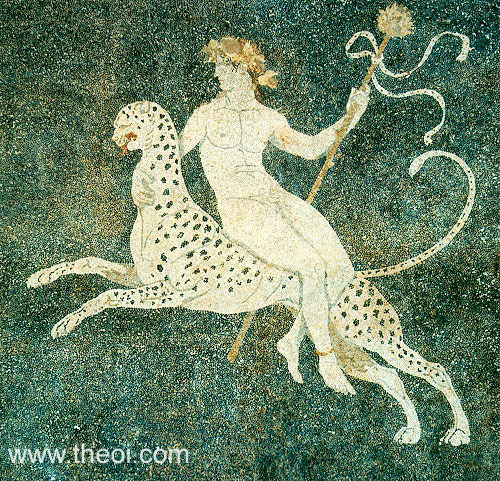
VI) Dionysos in service of political and religious doctrines: various uses
Multiple, complex, contradictory and shapeshifting: the god offered to the political and religious domains a very malleable material. For example, there are obvious links and mutual influences between the eastward journey of Dionysos and the eastward journey of Alexander. Alexander, just like his soldiers, and just like his historians, know of the story of the god’s travel to the East – the Dionysos of Euripides, in the Bacchants, said himself: “I left Lydia with his gold-fertile fields, I left the plains of Phrygia for the sun-burned plateaus of Persia, the walled cities of Bactrian, and the land of the Medes, frozen by winter ; and happy Arabia ; and finally all of Asia, laying by the salted waters…” Alexander took his army on the very steps of Dionysos. Of course, the Great was going to make the god the patron of his expedition, and as such Alexander was celebrated as the “new Dionysos” (a title that future rulers of Alexandria will also bear). The parallel grows stronger with the encounter by Alexander’s army of a town named Nysa, located near the mount Meros (a word that sounds similar to the Greek word for “thigh”) – the prince claimed the people of Nysa were descendants of the Greek people that Dionysos took with his on his own journey. However, in a complete circle, the adventure of Alexander the Great influenced greatly Dionysos’ own travels. India, for example, was never named in the tale of the Bacchants. But after the exploits of Alexander, Dionysos became the conqueror of India. Poets, painters and sculptors all depicted him taking part in this “war of India” that Euripides had never heard about. In the 5th century CE, this tale grew to enormous proportions thanks to Nonnus’ Dionysiaca, an epic in 48 chants, and where the Indian travel is described from chant 13 to 40.
Despite the recent doubts of some scholars, there is a possibility that Cesar and Augustus used for their political agenda the glory of this god celebrated everywhere in the oriental part of the Roman empire, and even in Rome itself – by both the Greco-Oriental population and the administrative elite of the Hellenism. Indeed, the assimilation between Dionysos and the Latium god Liber Pater had been done for a long time by now, and that despite some strong oppositions (such as the stern repression of the cult of Dionysos in 186). And the success of this religion was noticed by the political authorities. Servius commented what Virgil wrote in his Bucolics, about how Daphnis, on a “chariot pulled by Armenian tigers”, was the first to introduce the “thiasos of Bacchus”. Servius reminds his reader that in truth, it was Cesar that first brought the “mysteries of Liber Pater” to Rome – and as such behind the triumph of Daphnis, one reads as much the travels of Alexander as the exploits of Cesar… Two men that Augustus claims to be the heir of.
This “politic of Dionysos” knew its climax between the second and third century CE, through Hadrian the philhellenic, who demanded to be called the “new Dionysos”. In the same tradition as Alexander the Great, and as the many Hellenistic rulers, from Gallian (who, while leading a double fight against the Barbarians and the Christians, wanted to return to the Greek tradition) to Elagabalus (who had the habit of driving a chariot pulled by lions and tigers).
Dionysos was also used for philosophical and religious agendas. As such, the Orphics, reused in their beliefs the myth of the god’s murder by the Titans. Marcel Detienne wrote about how the myth of Dionysos was the perfect illustration for the main teaching of Orpheus: refrain from murder. In its double sense of 1) do not kill your fellow human being ; but also as 2) do not eat meat. On top of that, Dionysos’ resurrection echoed the belief in palingenesis of the disciples of Orpheus.
With this context, it makes sense that Christian writers, such as Clement of Alexandria or Firmicus Maternus, focused their attacks onto a myth that, for them, was a caricature of their beliefs and a parody of the sacraments of their own religion. Passion and Resurrection (Gregory of Nazianzus even used three hundred verses of the Bacchants in his Christus Patiem), Eucharist, and even the concept of Original Sin – because Dion Chrysostom wrote that mankind was born from the ashes of the Titans mixed with the earth. As such, humanity was part at the same time of the crime of the Titans, and of the divinity of Dionysos (who had been eaten by the Titans). The Christian attacks were also very strong because Orphism, through this myth, had brought to the cult of Dionysos the theology that it lacked (since in the Mysteries of Dionysos, the ritual had a larger and stronger place than the theory).

VII) A diversity of interpretations
In front of such a complex and elusive personality, it is impossible to give just one interpretation of the character of Dionysos. From the third millennium BCE to the fall of the Roman Empire, the god constantly played a role – his figure was constantly shaped by societies, governments and people. As such, the interpretations offered by mythologists allow us to better understand Dionysos, but they will never be complete or exhaustive. As much, all they can do is bring to light some key elements of his being.
While the mythologists of the early 20th century were prone to excesses, the interpretations of names such as Frazer, Farnell or Miss Harrison are still very interesting. Dionysos is first and foremost a vegetation god, a fecundity god, a chthonian god. Many of his ceremonies are rituals celebrating renewal. He is a god of plants; his emblem if the thyrsus, a branch or a reed stalk crowned by leaves of ivy/vine, or by a pine cone. All these plants play a important role in both the rites and the myth of Dionysos, even though from the 7th century BCE onward he specializes himself as the god of the grapevine and of wine. Dionysos is the lord of the tree. As we saw before, he is related to the Oriental mother-goddesses and to the Aegean world. His wife is Ariadne – who might have been during the Classical era a human, but that was once an Aegean goddess of vegetation. Dionysos is the master of both animal and human fecundity – his favorite companions, the satyrs, the donkeys, the goats, the bulls, are all depicted with a very large phallus. He went down into the Underworld to bring back his mother Semele, and he presides over the Anthesteria, which was a celebration of the dead. Zagreus was believed to have for a mother Persephone, and for a father either Zeus or Hades – and in fact, Zagreus was sometimes identified as being an alternate identity of Hades. This chthonian side of Dionysos was developed in his mysteries: the initiation, the purifications, the teaches of sacred formulas have for a main purpose to allow the dead to escape all the dangers that threaten their travel to the afterlife ; and ultimately, to allow them to find happiness in the Hades.
The Bacchic drunkenness and the possessios/trances of the Menads have also brought forward numerous psychological, psychoanalytical and ethnological commentaries. The dances of the Bacchants were compared to those of the whirling dervishes, of the Jewish Hasidim, of the Siberian shamans and of the American Shakers. This phenomenon was proven to have been widespread throughout all of the Antique Mediterranean world – and to still be existing today in a part of Africa. Séchan-Lévêque noted that the “delirium of the Bacchants” was in many ways similar to neuropathic manifestations. Convulsive and spasmodic movements, the body bending backwards, the neck being thrown around… Both also involve a feeling of depersonalization, the feeling of the self being invaded by an outside persona or entity. Psychanalysts saw a parallel between the mechanisms of the Dionysian possession and various concepts of child-psychanalysis: they claimed that the ritual of the god had a therapeutic effect. The Dionysos-Hades becomes a Dionsyso-Asclepios.
Another theory that should not be ignored is the theory of the “pharmakos”, or the theory of the “scape-goat”, that was popularized by Frazer and then by René Girard in his interpretation of Euripides’ play. The tragedy of the Bacchants presents itself at first like a ritual bacchanal. All differences are erased: all take part in the celebration, be them old or young, male or female, citizens or slaves. But the party goes wrong, violence arrives. The difference becomes an inversion: women perform martial activities, men disguise themselves into women. Human and animal worlds are confused for one another: the Bacchants rip apart of a herd of cow they mistake for men, Pentheus ties up a bull he thought was Dionysos, Agave murders Pentheus while seeing before her a lion. Pentheus, in his transvestite outfit, is a Carnival prince, a temporary king – as Jeanne Roux notes, he is at the same time the scape-goat carrying with him all the soiling and vices of the past year, and the sacrificial victim to open a new and clean year. The symbolism becomes even more obvious due to the fact that Pentheus, in his female disguise, climbs on top of a pine and falls from it. A. G. Bather, in The Problem of the Bacchae (Journal of Hellenic Studies, 1894), noted that in Russia, during Pentecost Thursday, there was a very similar ritual. Villagers had to cut down a young pine-tree and disguise it as a woman before bringing “her” to the village in great joy. Three days later, on Trinity Sunday, the wooden figure was taken out of the village and thrown in a body of water. In Euripides’ play, at the end of the party, the pine-tree is ripped away, the king is killed and torn apart: Pentheus is inflicted a diasparagmos (a dismemberment) by the hands of his own mother and of his aunts. Which in turn will become new scapegoats, as they will be banished from the city afterwar. A new order will rule over Thebes: as René Girard notes in La Violence et le sacré (Violence and the sacred), Dionysos is the god “of the successful lynching”. However we saw previously that Pentheus is the double of Dionysos. Just like his adversary/reflection, the god, in the myth of the Titans, also suffers a diasparagmos. As such there is an identification between the pine-tree that is uprooted, and Dionysos Dendritès, god of the trees. While in Euripides’ play the god appears as the organizer and the force behind the scapegoat ceremony, it is possible that in ancient times he used to be the victim of said ceremony.
Finally, numerous analogies bring Dionysos close to the “kouroi”, the novices that undergo initiation-trials. Pausanias describes how Cadmos placed Semele and young Dionysos in a chest that was thrown in the water and ended in Brasiai/Prasiai (a port of Laconia). This type of trial was also known by other great heroes – Perseus, Moises, Romulus. Just like the initiated ones of the three first classes of Ancient India (the dvija), Dionysos is “twice-born”. Just like Achilles, Herakles and Jason, who were all raised by the horse-man Chiron, Dionysos knew animal-men during his childhood: the goat-men that were the satyrs and the silenes ; but also wolf-men, such as Lycurgus (whose name means “He who acts as a wolf, from lukos “wolf” and “ergon”, action), or Athamas (that Apollodorus compares to a wolf). Just like Achilles that was disguised as a girl, just like Theseus that was mocked for his dress and braided hair, just like Herakles that had put on a dress before queen Omphalus, Dionysos knew the experience of the feminine cross-dressing. Just like Achilles, Melicertes, Herakles, Pelops and Jason, there is the trial of the cauldron – killed, dismembered and boiled, he was resurrected. (Jeanmaire wrote that it is a legend with a strong initiation symbolism, and that seems to answer to very archaic practices explaining or interpreting the dangers that threaten children and teenagers). Just like in African initiation rituals, the rhombus played a key part in his death-resurrection. Just like Pelops, whose homosexual loves for Poseidon have analogies with the initiation of young Cretans, Dionysos, with the mysterious Prosumnos, acts as the hero of an initiation-adventure. Just like Odysseus, Herakles, Orpheus, Theseus, Aeneas or Jason (the latter only through symbolism), he went into the Underworld. Finally, just like Theseus and Gilgamesh, he plunged in the water (and even twice) to escape Lycurgus and to find his mother in the Hades. All those trials are so many shapes of initiation rituals, of obligatory rites of passages allowing the teenager to leave the world of childhood and to join the world of adults.
As such, despite all the critical efforts to understand Dionysos’ personality, to bring an exhaustive interpretation including both his complexity and diversity, the god keeps escaping our minds, breaking our settings, removing the chains with which we would try to bind him. All the way until the end, he will stay elusive. So let us remember how, in both the Homeric hymn to Dionysos, and the Bacchants, Dionysos is always presented as the “un-binder”, as the “Eleuthereus”, the “Luaios”, the “Lusios”, the one that detaches, that sets free ; the god on who all ropes and all binds fall to the ground, the god who can escape any net without effort, the entity that can never be trapped because all those that think they caught him are in fact not even touching him.
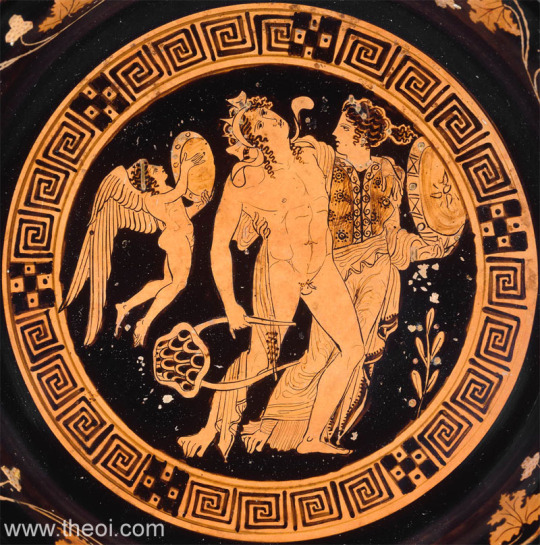
#dionysos#dionysus#greek god#greek gods#mythology#ancient greece#ancient rome#roman religion#greek religion#roman gods#roman mythology#alexander the great#bacchants#pentheus#orphic cult#orphic religion
55 notes
·
View notes
Text

8: Ares Gynaecothoenas
"In Homer, Ares is both an abstract noun denoting "war" and the deity, blood-stained and bellowing, who personifies the grim and horrific aspects of war. Not surprisingly, Ares enjoyed only a limited worship, concentrated in the Peloponnese and central Greece. Yet he was father to numerous ancestral heroes, and played an important role in the legendary origins of Thebes."
"Cults of Ares were often connected to battle lore, and as the ancestor of the Amazons, Ares was associated with stories of women warriors. In Argos and Tegea, legends told how the women of the city took up arms to battle invading Spartans, and having achieved victory, established cults of Ares from which men were excluded."
Ancient Greek Cults: A Guide by Jennifer Larson.
Gynaecothoenas, "the god feasted by women", was a surname of Ares at Tegea.
315 notes
·
View notes
Text
Dionysus Research
Dionysus is the god of wine-making, vines, vegetation, fertility, festivity, insanity, ritual madness, religious ecstasy, and theater. Also referred to as Bacchus, which the Romans later adopted, was originally found in a written record in Mycenaean Greece around 1300 BC. Jane Ellen Harrison, a British classical scholar, believed that Dionysus means "young Zeus. His origins are uncertain, and his cult took many forms. One was said to have originated in the Zagros Mountains, originally to worship or was associated with wine, which was before Mycenaean Greece even existed. The cult then made its way to the now-established Mycenaean Greece where they founded and started worshiping the then Dionysus.
#dyonisus#ancient greece#greek mythology#greek myth#cult of dionysus#hellenic gods#writing#essay#history#ancient history
14 notes
·
View notes
Text
can't believe people just live their day to day lives without thinking about the eleusinian mysteries??? like??? not even once????
#not even kore?#KORE?#persephone#mystery cult#eleusinian mysteries#cult#tagamemnon#queueusque tandem abutere catilina patientia nostra#demeter#ancient greece#greek mythology#greek gods#history#queue are made by history#archaeology
26 notes
·
View notes
Note

How did they purify the roosters?
#roosters are evil man how did they do it?#also I don’t think Heracles is the most misogynistic Greek deity (he has other relatives who were just as bad if not worse than him)#so I do think this is an exaggeration since just bc a few of his cults where weird doesn’t mean that’s how all Greeks viewed him#but misogynist seemingly being an epithet is so fucking funny#ancient Greeks be normal about women challenge!#impossible#greek mythology#ancient greek mythology#greek pantheon#Heracles#Hercules#hebe#Hera
11 notes
·
View notes
Text
The more I continue extensive researching and deep digging into the history of ancient Greece and the ancient Greek religion, the more things I discover that are new and surprising to me even to this day, which are making me retweek and revamp what I think I've always known about the Hellenic deities on the regular. Artemis has been my patron goddess for almost a decade and a half now. I thought I knew all I needed to know about her. Well, I don't, far from it.
That's what it takes to keep learning, I think, to constantly be taken by more surprises, by "ok this is news to me", to always have to rework and rearrange my knowledge base as well as belief system, because they'll never stop being challenged, since I'll never stop learning.
Like, the part where, Stephanie Budin and her colleagues have written: priestesses of Artemis in her cults during ancient times were actually in the majority of cases, not permanent and life long positions. Maidens would serve the roles of Artemis's priestesses, then relinquish them when they eventually married, which was not only normal but also expected in Artemis's cults.
#artemis#artemis devotee#daughter of artemis#ancient greece#greek history#hellenic polytheism#hellenic pantheon#deities#religions#ancient greek cults#ancient greek religion#studyblr
12 notes
·
View notes
Text
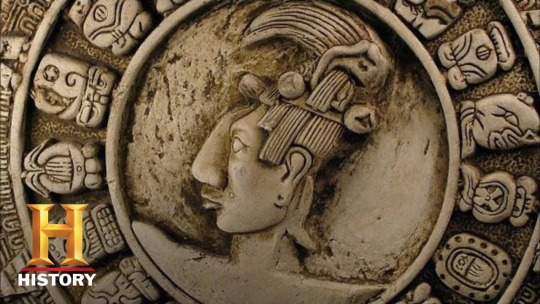
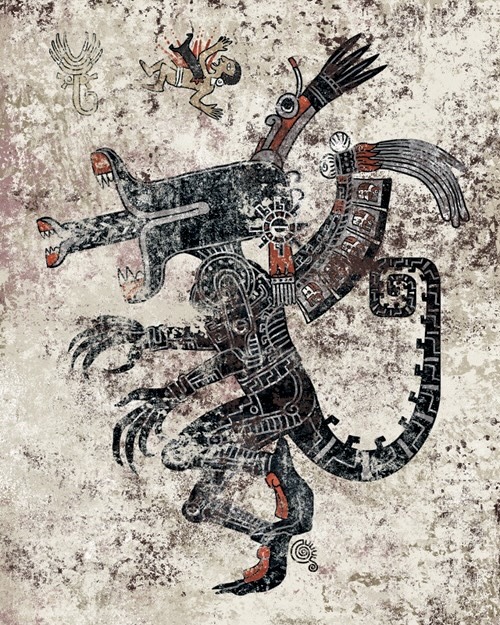
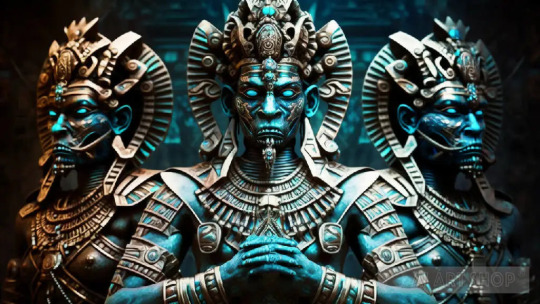

Why all the Ancient aliens are so ugly and ruthless beings, nothing found that is civilized, or from supreme being peaceful and intelligent. What ever the origin is , its ugly, ruthless, combative, enslaving, destructive and made of stone.
What ever it is it cant be called intelligent except the flat surfaces of stones and this can be explained.
They really did not leave anything described as advanced ⁉️ nothing made of titanium or carbon fiber or electronic simple circuitry or advanced mechanically or any design of engine.
Enough of this ancient aliens and Annunaki Shit .. please
➰💱👁️🗨️
Came from heaven my ass 🤔 and what is that banana like object that is going in his but, teleportation dildo.
#aliens#annunaki#sexy#motorcycle#egyptian#ancient sculpture#gods#sculpture#greek mythology#rome#bible#warship#death cult#civilization#ancient history#rhythm heaven#hot as hell#demon oc#angel
11 notes
·
View notes